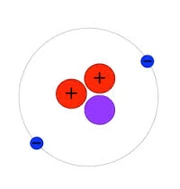
An atom of H-3
Helium-3 (He-3) is a light, non-radioactive isotope of helium with two protons and one neutron.
On Earth, He 3 abundance is low by comparison with He 4. In the atmosphere, relative abundance [He 3]/[He] is 1.38 (molar) ppm. At the moon's surface, helium from solar wind is deposited in the upper layer of regolith. Relative abundance in regolith is on the order of [He 3]/[He] = 0.001. The two numbers differ because helium trapped on the moon's surface comes mainly from the sun's outer layers, so the primordial [He 3]/[He] ratio determined big-bang nucleosynthesis governs relative isotope concentration at the moon's surface. On earth, material from the solar wind remains in the upper atmosphere - eventually diffusing away back into space. Near the ground, almost all helium comes from alpha decay, so most helium is He 4.
The solar system's gas giants contain large amounts of helium, which was accreted directly from the original solar nebula).
In the proton-proton chain, the major process by which the sun releases energy, He 3 is an intermediate. In the last two steps of the chain, two He 3 nuclei fuse to produce He 4: 2 (He 3) --> Be 6 --> He 4 + 2p. Fusing two particles with +2 charges requires more energy to overcome electrical repulsion than fusing two with +1 charges, so that last fusion is what determines minimum temperature for the full proton-proton chain. Almost half the energy released during the formation of an He 4 nucleus comes from He 3 fusion, though, so energy release per hydrogen atom consumed is much smaller when fusion stops at He 3. It is possible that this marks a dividing point between low-mass stars and high-mass brown dwarfs.
As the universe ages, the near-stars will gradually make He 3 very abundant,
